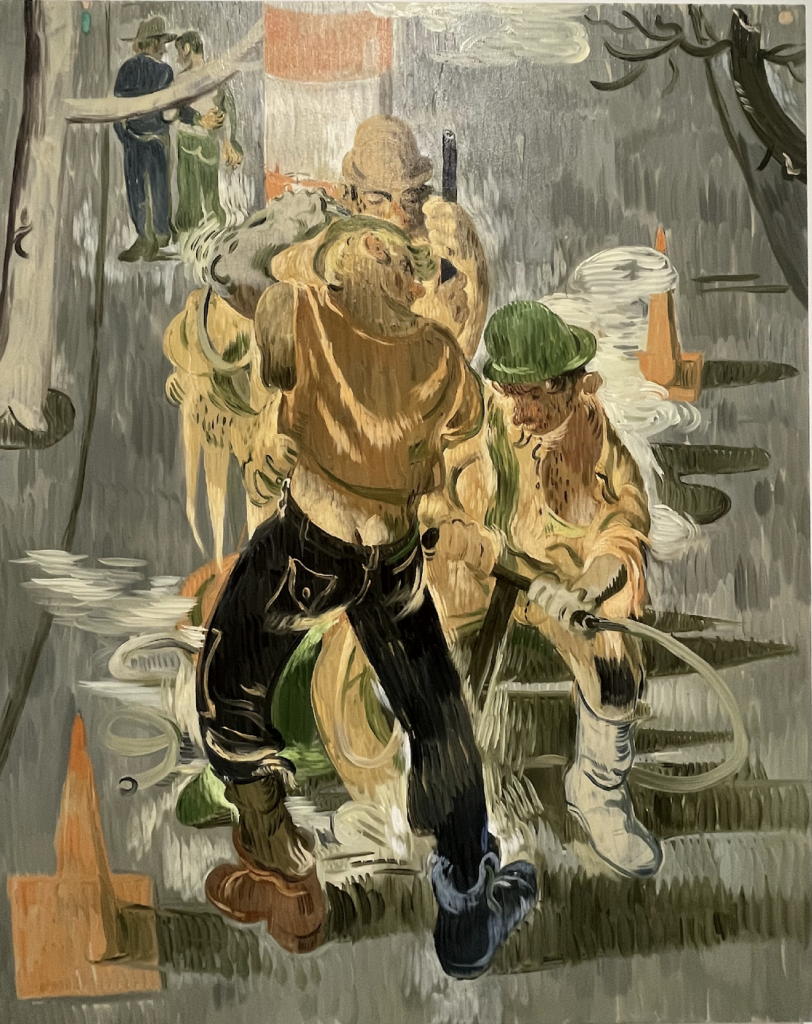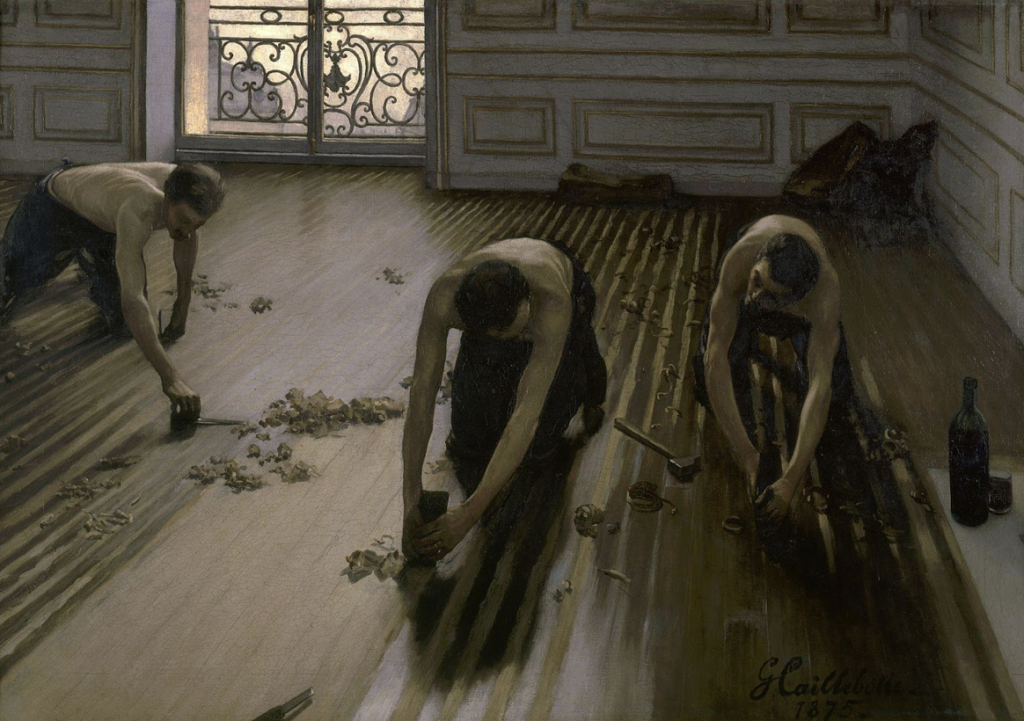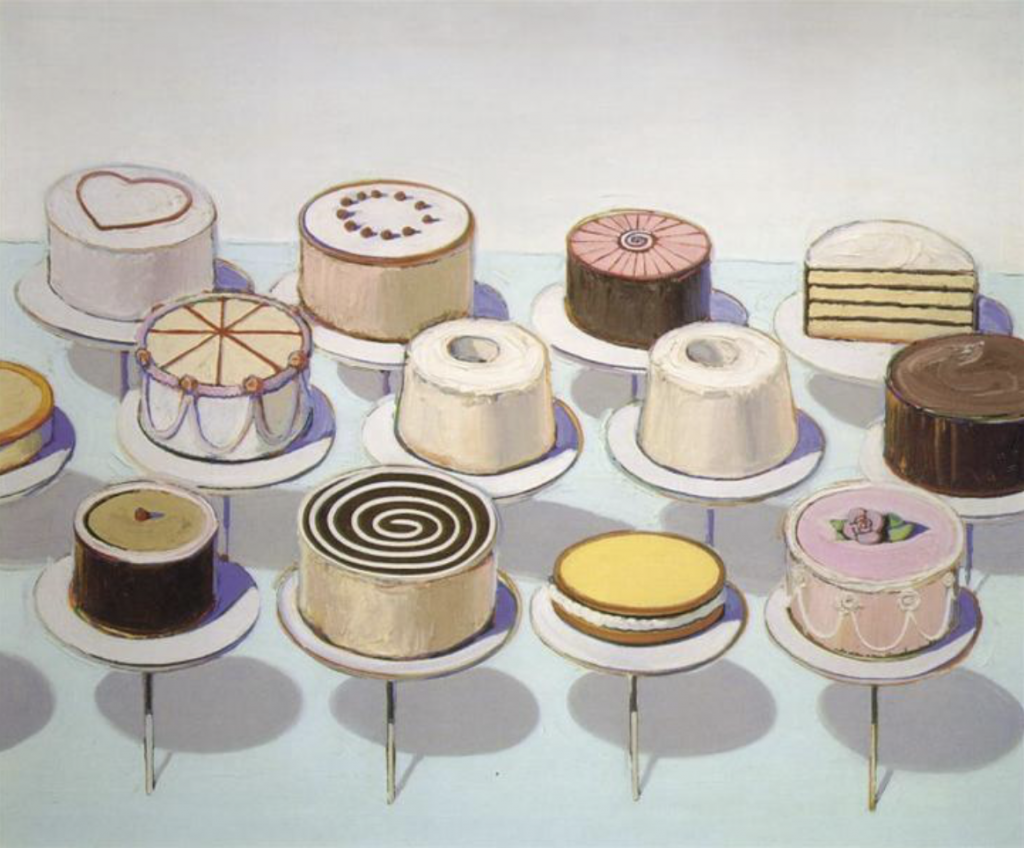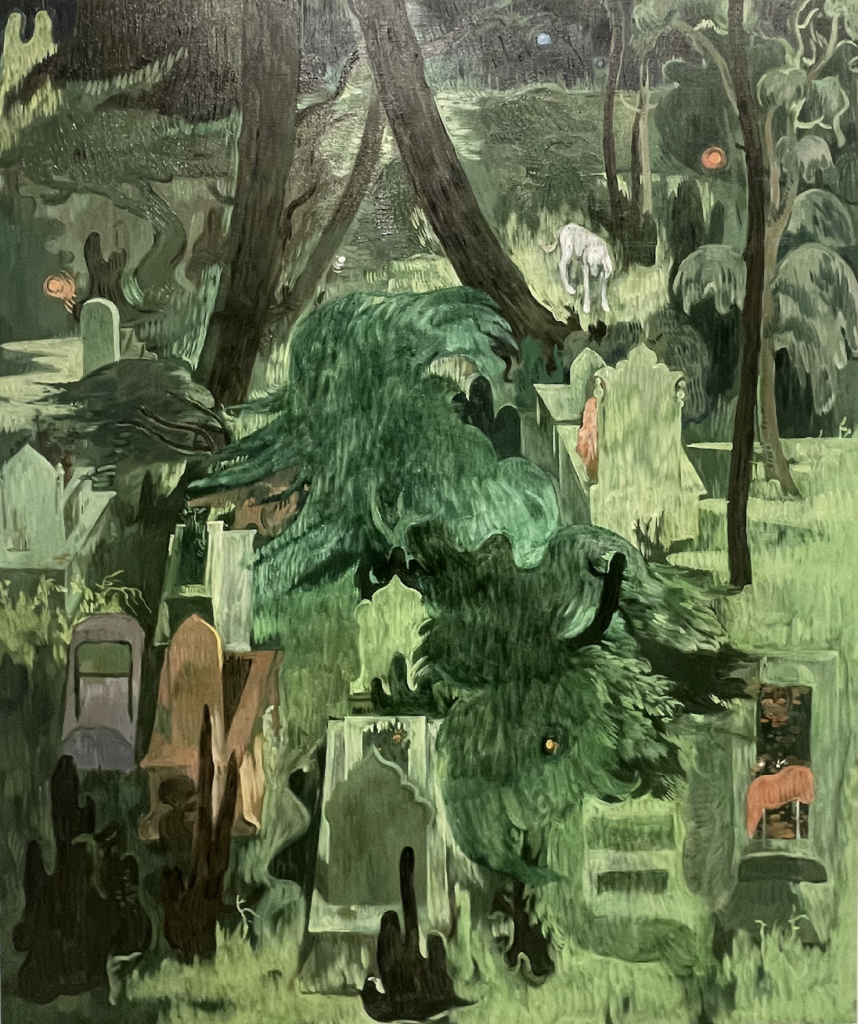Fall in Unordinary Love: Salman Toor in Tampa
by Richard Ellis
This spring, visitors of the Tampa Museum of Art (TMA) have the uncommon chance to view a profoundly whimsical exhibition of works by a preeminent contemporary painter. Salman Toor: No Ordinary Love, features more than forty-five paintings and works on paper completed between 2019 and 2022. The exhibition is organized by the Baltimore Museum of Art and is on view at the TMA from February 23rd through June 4th, 2023.
Born in 1983, in Lahore, Pakistan, Salman Toor resides and works in New York City and exhibits internationally. His oeuvre primarily consists of dreamlike scenes, in which cartoonish figures appear suspended like marionettes, caught in the plotlines of ambiguous narratives. The stories are drawn from moments of the urban lives of imagined queer young men, as well as from the artist’s own lived experience and those of his friends. The emotional atmospheres of his canvases fluctuate between intimacy and isolation, contentment and embarrassment, and tenderness and violence.
This exhibition is important and timely as it draws attention to international human rights issues as well as domestic queer politics. In Pakistan, acts of homosexuality are punishable by life imprisonment, or even death in extreme cases.1 In America, LGBTQ+ rights, representation and recreation are coming under fire from lawmakers, politicians, and homophobic and transphobic members of the public who are banning or restricting drag shows throughout the country.
On view in the museum’s newly constructed gallery space, the exhibition consists of oil paintings done on panel and canvas, several drawings done in charcoal, ink, and gouache, and two of the artist’s sketchbooks. This body of works offers conceptual, material, and technical variety while also showcasing Toor’s characteristic style. Despite the surreal quality of many of Toor’s paintings and the specificity of his subject matter, the moments that he constructs are deeply sensitive to the human condition. There is a naivete to his figures, but their innocence is occasionally broken by the salacious scenarios in which they appear entangled.
Toor’s paintings reward the visually literate and those well-versed in Western art history. Drawing from the European painting tradition, he invites us to traverse through centuries of time without ever leaving our contemporary moment behind. Toor brings this legacy into our times to confront colonial structures that still confine us. In postcolonial fashion, Toor turns the canon on its head by replacing the typical subjects of Western easel paintings with queer, brown-skinned boys and men. Toor demonstrates his mastery over the Western tradition in a bold act of subversion that begs the question of who owns whose art history.


When visitors enter the gallery, they are immediately confronted by Construction Men (Figure 1), a scene that continues the homoerotic celebration of male laborers that can be traced back to Gustave Caillebotte’s The Floor Scrapers (Figure 2), of 1875, though with a campy flare evocative of costumes for The Village People. From there, visitors may circulate the room and explore the three thematic categories that the works are separated into, including desire, tradition, and family. Many of the paintings are neatly spaced along the horizon line of the gallery walls, with carefully adjusted spotlights illuminating each one. His smaller works, though, are clustered together on the south wall, in a way that evokes the salon-style displays of public galleries in the nineteenth century. This strategy slows down the viewing experience and aligns with Toor’s connection to artistic conventions of the past, but it also makes it difficult to see the details in each of them closely, especially for viewers whose vantage point is lower than others.
Not all the works in the catalog make an appearance at this venue. Two notable exclusions include The Latecomer, 2021, and the monumental Fag Puddle with Candle, Shoe and Flag, 2022, which is featured on the cover of the catalog edited by Asma Naeem and available for purchase at the Museum’s store. The painting is a self-referential triumph that blends symbols from Toor’s lexicon, including phalluses, shoes, used condoms, and tombstones. It is perhaps the standout of the show, but it is not on view at the TMA because it was swiftly purchased by the Metropolitan Museum of Art. Congratulations are in order for the artist as this painting is the first of his to be acquired by the prestigious institution, but I lament the missed opportunity for a Floridian audience to view this painting.
While the compositions that underly many of Toor’s canvases are taken from monuments of Early Modern European art, these works find themselves quite at home at the TMA, even though such a collection is conspicuously absent. The TMA has historically been known for its collection of classical art from Greece and Southern Italy, but its exhibition programming and the development of its permanent collection have also been centered around outlier art of the modern and postmodern eras. The humor, irony, postcolonial angst, and queer grunge, that we find on the surface of Toor’s paintings bear an uncanny affinity with the irreverent and kitschy contemporary art scene of the greater Tampa Bay area.

Several of the works made for this exhibition pull directly from works in the Baltimore Museum of Art’s collection of European paintings from the 17th– to the 19th-centuries. Attention to Toor’s references to early modern art is well-established but has perhaps overshadowed his visual connections to later painters. Toor typically uses oil paints over a surface primed with dark brown acrylic paint. His style is painterly, with thick, visible brushstrokes. The built-up textures of his paintings have been described as frosting on a cake, not unlike Wayne Thiebaud, whose paintings of seemingly mundane desserts and pastries, such as Cakes (Figure 3), 1963, were imbued with a postmodern sensibility and likewise question notions of desire, consumption, class, and privilege.2

The Western canon is not the only power structure that Toor seeks to upend. Toor also takes issue with the endemic homophobia that plagues his home country of Pakistan, as well as most other Muslim-majority nations. The perils that LGBTQ+ people face within these communities is a topic brought forth by several of Toor’s paintings, such as Stone Throwers, Night Capture (Figure 4), and The Vigil. The threat of violence compels us to hide beneath the protective cover of night and within the fickle safety of wooden areas, where individuals may cruise at their own risk. In Shadow Park, Toor provides us a glimpse into the underworld of queer desire that echoes the sexually charged nightmare-fantasies of Robert Gober’s The Heart is Not a Metaphor.

In some of Toor’s paintings such as Thunderstorm and Back Lawn, we see domestic gardens as a space for freedom and unbridled affection. In Cemetery with Dog (Figure 5), Toor explores a different setting entirely, in which the homoerotic paradise of Sa’di’s garden is now a graveyard.3 The scene has the isometric perspective of Persianate manuscript paintings, through which we peer down at above-ground graves and tombstones. Unlike most of his paintings, this one is conspicuously absent of any visible human figures, though it hardly feels like an empty landscape. By searching for a person, we come to the grim realization that a graveyard is never an empty landscape, as the ground literally contains invisible bodies. In the background, there are trees entwined, an established motif in painting, prose, and poetry from the Islamic world for lovers yearning to embrace one another.4 By conflating the garden with the cemetery, and life and death, this painting serves as a dark reminder of the risk of pursuing forbidden love.
Toor is known for his proclivity for green, a color that has, perhaps coincidentally, also enjoyed an emblematic role in Islamic culture. Green is the color of the Prophet Muhammad, who is said to have privileged the color above all others, as well as the color of paradise, which is envisioned as a garden.5 For modern artists in the West, such as Ernst Ludwig Kirchner and Pablo Picasso, green indicates a sickness manifests on multiple levels. Toor says that he is aware of the poisonous associations with green, but for him, the color is “velvety, nocturnal, and comforting.”6 The conflicting potentialities for the symbolic significance of green in Toor’s paintings, in a way, queer the color itself.
At the heart of his work, Toor celebrates the common love found in causal romances of the sex-positive queer world by elevating it by giving it the treatment of one that is found beyond the realm of the ordinary. He celebrates these because they are valuable, and we take them for granted, forgetting that these small acts of seemingly meaningless affection are a luxury not afforded to all.
Glowing like the green light from F. Scott Fitzgerald’s The Great Gatsby, these gleaming, verdant paintings shine into the night, beckoning us into a world of uninhibited frivolity, misplaced desire, and dangerous trysts. Like Nick Carraway, the narrating protagonist of the hazy tale, Toor seems to find dissatisfaction with the world in which he has entered, where love is free, and therefore made worthless. Lovers are had and then disposed. Forbidden love is no longer forbidden, and therefore has become ordinary. Toor gifts us a fresh perspective by showing the value that remains in public displays of affection and to show us that there is nothing at all ordinary about such love.
Salmon Toor: No Ordinary Love is on view at the Tampa Museum of Art through June 4, 2023. The exhibition is organized by the Baltimore Museum of Art.
About the author
Richard Ellis is an adjunct professor at the University of Tampa, in the Department of Art & Design, and at the University of South Florida, in the School of Art & Art History. He holds a B.A. and M.A., both in art history and from the University of South Florida. His areas of interest include Islamic art and architecture, modern and contemporary art of the Middle East, North Africa, South Asia, and the diasporas, as well as Orientalism.
Footnotes
- “Pakistan,” Human Dignity Trust, accessed May 8, 2023, https://www.humandignitytrust.org/country-profile/pakistan/.
- Asma Naeem, “Salman Toor’s Brown Boys,” in Salman Toor: No Ordinary Love, ed. Asma Naeem (New York and Baltimore: Gregory R. Miller & Co. and the Baltimore Museum of Art), 10.
- Mika Natif, “The generative garden: Sensuality, male intimacy, and eternity in Govardhan’s illustration of Sa‘dī’s Gulistān,” in Eros and Sexuality in Islamic Art, ed. Francesca Leoni and Mika Natif (Farnham and Burlington: Ashgate, 2013), 3.
- Michael Barry, “Illustrating ‘Attār: A Pictorial Meditation by Master Habīballāh of Mashhad in the Tradition of Master Bihzād of Herat,” in ‘Attār and the Persian Sufi Tradition: The Art of Spiritual Flight, ed. Leonard Lewisohn and Christopher Shackle (London and New York: I.B. Tauris, 2006), 148.
- Mohammad Gharipour, Persian Gardens and Pavilions: Reflections in History, Poetry, and the Arts (London and New York, I.B. Taurus, 2013), 24.
- Evan Moffitt, “Green as the Night” in Salman Toor: No Ordinary Love, ed. Asma Naeem (New York and Baltimore: Gregory R. Miller & Co. and the Baltimore Museum of Art), 49.
Bibliography
Barry, Michael. “Illustrating ‘Attār: A Pictorial Meditation by Master Habīballāh of Mashhad in the Tradition of Master Bihzād of Herat.” In ‘Attār and the Persian Sufi Tradition: The Art of Spiritual Flight, ed. Leonard Lewisohn and Christopher Shackle, 135-64. London and New York: I.B. Tauris, 2006.
Gharipour, Mohammad. Persian Gardens and Pavilions: Reflections in History, Poetry, and the Arts. London and New York: I.B. Tauris, 2013.
Human Dignity Trust. “Pakistan.” Accessed May 8, 2023. www.humandignitarytrust.org/country-profile/pakistan/.
Naeem, Asma, ed. Salman Toor: No Ordinary Love. ed. New York and Baltimore: Gregory R. Miller & Co. and the Baltimore Museum of Art, 2022.
Natif, Mika. “The generative garden: Sensuality, male intimacy, and eternity in Govardhan’s illustration of Sa‘dī’s Gulistān.” In Eros and Sexuality in Islamic Art, ed. Francesca Leoni and Mika Natif, 43-64. Farnham and Burlington: Ashgate, 2013.
